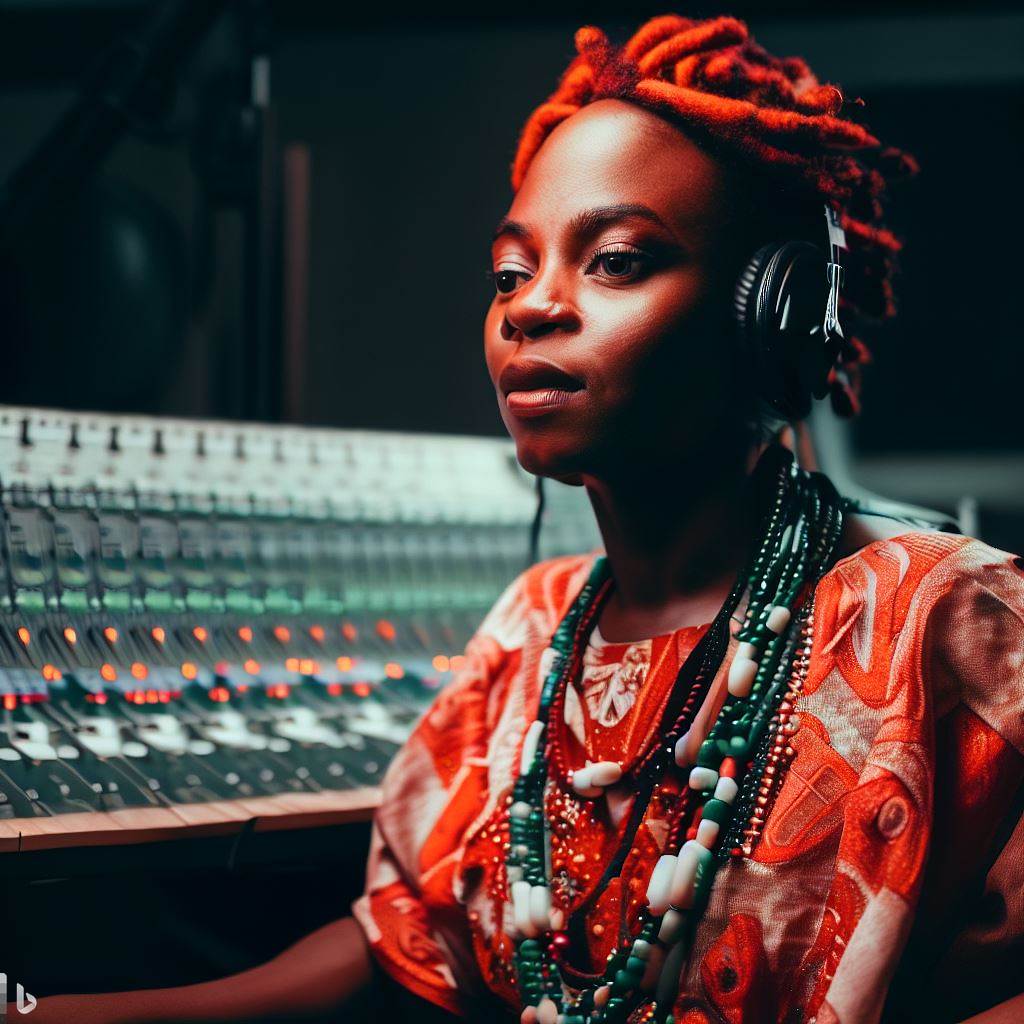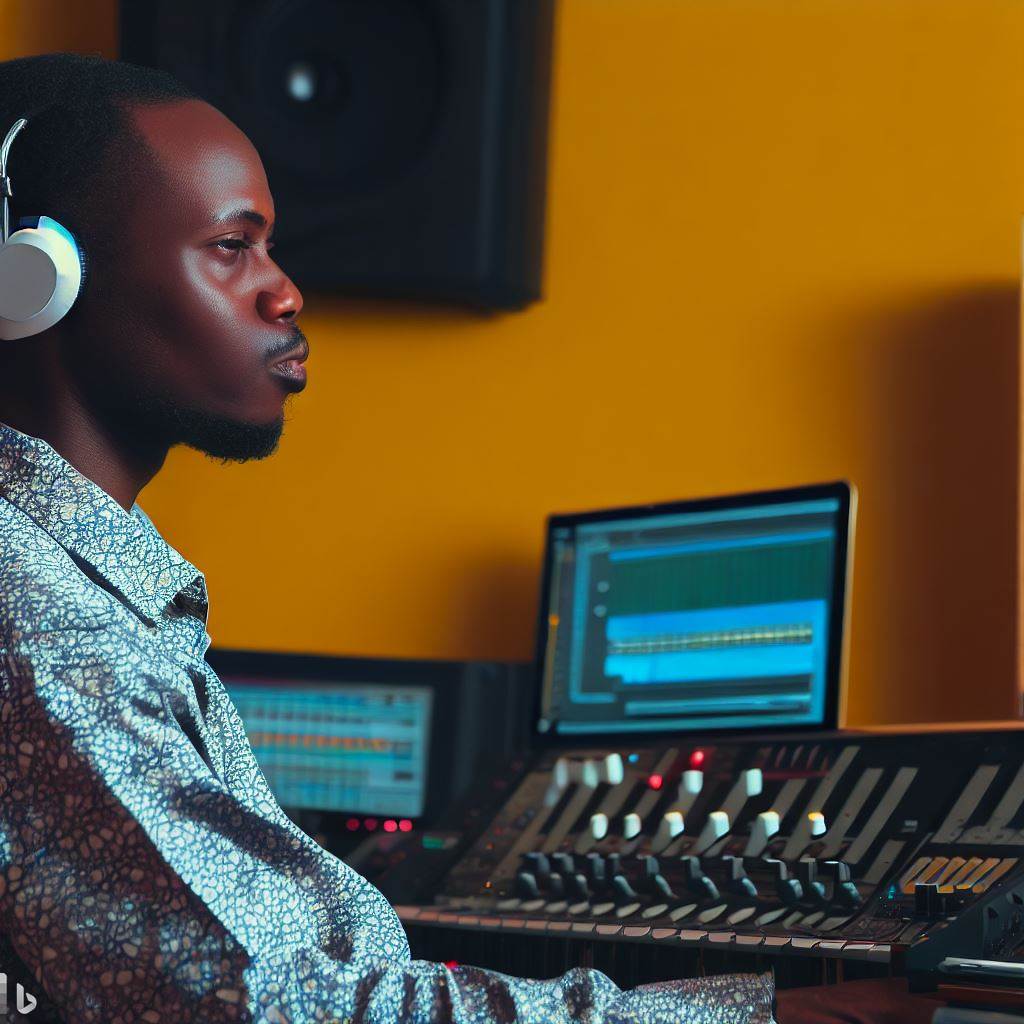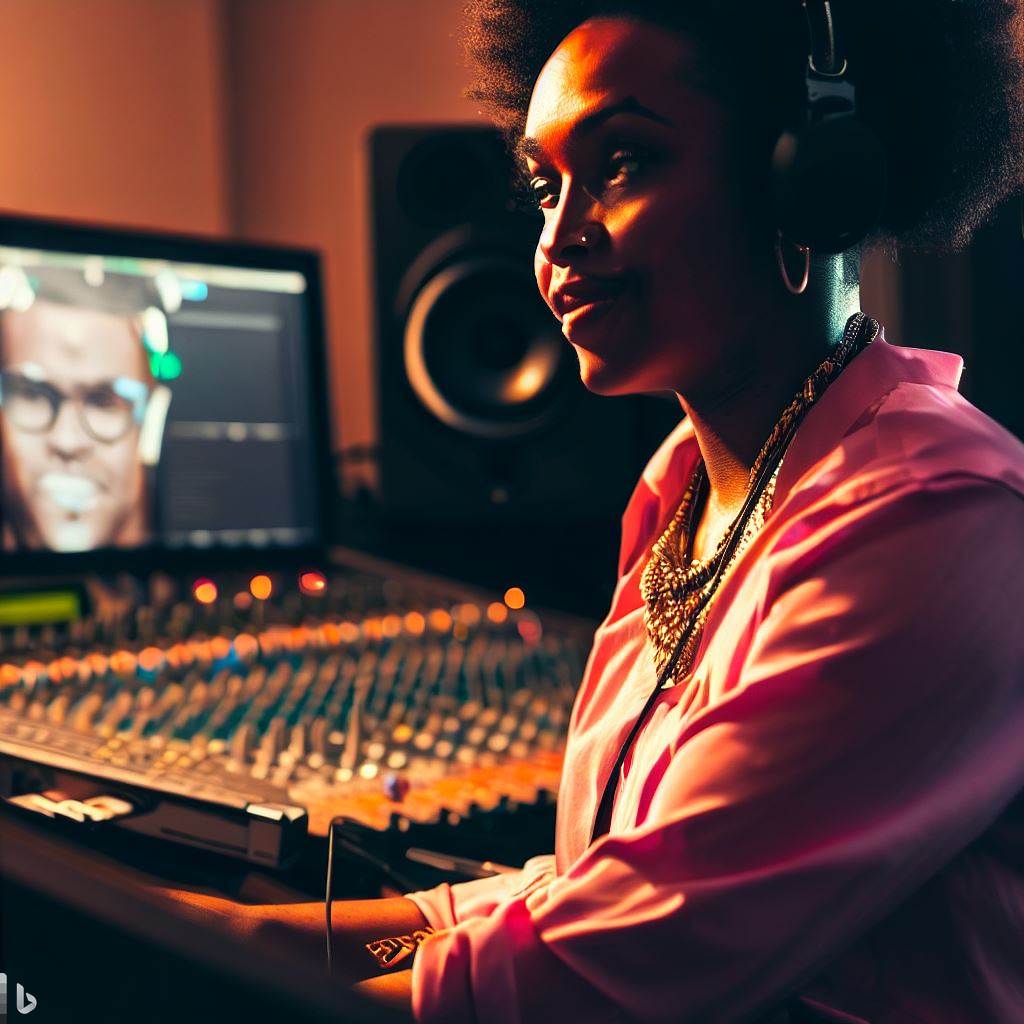Introduction
Nigeria’s music industry has experienced immense growth and evolution over the years, becoming a global force.
From the emergence of highlife in the 1950s to Afrobeats dominating the international scene today, Nigerian music has transcended boundaries.
Transition to the topic of traditional elements in modern Nigerian music production
Despite this growth and evolution, Nigerian artists have remained rooted in their traditions, infusing traditional elements into modern music production.
Nigeria, a country rich in cultural diversity, also boasts a vibrant music scene that combines traditional elements with modern production techniques.
In this post, we will explore the influence of traditional Nigerian music on modern music production.
Traditional Nigerian Music Forms and Styles
Nigeria is home to various music forms like highlife, juju, and afrobeat, each with its distinct characteristics.
Highlife, a fusion of traditional rhythms and Western influences, emerged in the early 20th century.
Juju music, known for its intricate guitar work and talking drums, gained popularity in the 1940s.
Afrobeat, pioneered by Fela Kuti in the 1970s, combines traditional Nigerian rhythms with jazz and funk.
Importance of Traditional Music in Nigerian Culture
Traditional Nigerian music serves as a cultural anchor, preserving the customs, values, and heritage of different ethnic groups.
It is deeply intertwined with rituals, ceremonies, and social gatherings, providing a medium for storytelling and social commentary.
Additionally, traditional music offers a sense of identity and belonging to Nigerians, fostering unity and pride.
Traditional Instruments Commonly Used in Nigerian Music
- Talking Drum (Dundun): This hourglass-shaped drum is played by squeezing the ropes attached to its sides. It mimics the tonal inflections of the Yoruba language, enabling drummers to communicate complex messages.
- Shekere: Made from a dried gourd with beads woven around it, this percussion instrument enhances the rhythmic texture of Nigerian music. It is played by shaking or hitting it against the palm to create shakers or rattling sounds.
- Omele (Thumb Piano): This handheld instrument, consisting of metal or bamboo strips attached to a resonator, is plucked with the thumbs to produce melodic notes. It often accompanies vocal performances.
- Agidigbo: Also known as the thumb piano, it features metal or wooden tongues that are plucked. The agidigbo adds a melodic and hypnotic element to traditional Nigerian music.
- Udu: This clay pot drum produces a range of sounds depending on how it is struck. Its versatility allows it to serve as both a rhythmic and melodic instrument.
Integration of Traditional Elements in Modern Nigerian Music Production
Modern Nigerian music producers continue to incorporate traditional elements to create a unique sonic identity.
They utilize traditional instruments alongside electronic sounds and digital production techniques.
By blending traditional rhythms, melodies, and instruments with contemporary elements, artists can appeal to a wide audience while preserving their cultural roots.
Traditional Nigerian music forms, such as highlife, juju, and afrobeat, have left an indelible mark on modern music production.
They not only reflect the rich cultural heritage of Nigeria but also contribute to the country’s artistic diversity.
By embracing traditional elements and incorporating them into modern production, Nigerian musicians are ensuring that their music remains relevant and timeless.
Read: Making Beats: Software Choices of Top Nigerian Producers
Modern Nigerian Music Production
The incorporation of traditional elements in modern Nigerian music production is a fascinating phenomenon that showcases the rich cultural heritage of the country.
As Nigeria continues to embrace modern technology and globalization, its music industry has also evolved, leading to the fusion of traditional and contemporary styles.
Influence of Modern Technology and Globalization
Modern technology has played a significant role in shaping the development of Nigerian music production.
In the past, traditional instruments such as the talking drum, shekere, and kalimba were predominantly used.
However, with the advent of digital audio workstations, synthesizers, and drum machines, producers now have a wider range of tools to experiment with.
Globalization has also had a profound impact. Nigerian artists now have access to a global audience, allowing them to experiment with different sounds and styles.
This exposure has led to collaborations with international artists and the incorporation of diverse musical influences.
Genres Incorporating Traditional Nigerian Elements
- Afrobeat: Afrobeat, popularized by Fela Kuti, blends traditional Nigerian rhythms with jazz, funk, and highlife. The use of Yoruba chants, traditional percussion, and brass instruments is a defining characteristic of this genre.
- Highlife: Highlife music, originating in Ghana and Nigeria, combines elements of Western and indigenous African music. It showcases the influence of palm-wine music, which is characterized by upbeat rhythms, guitar melodies, and lyrical storytelling.
- Juju: Juju music is a genre that emerged in the 1920s and incorporates elements of Yoruba folklore and traditional rhythms. The use of the talking drum, guitar, and accordion creates a distinct sound that is both traditional and modern.
- Afropop: Afropop is a genre that blends African rhythms and melodies with Western pop and hip-hop. It often features traditional Nigerian instruments alongside electronic elements, creating a unique fusion of sounds.
- Makossa: Although originally from Cameroon, makossa has gained popularity in Nigeria. It combines elements of jazz, highlife, and Congolese rumba, with traditional African beats at its core.
The Importance of Preserving Traditional Elements
While modern technology and globalization have brought about exciting changes in Nigerian music production, it is crucial to preserve traditional elements.
Traditional music forms an integral part of the country’s cultural identity, and its incorporation in modern music production allows for the celebration of Nigerian heritage.
Preserving traditional elements also ensures that future generations are connected to their roots and have an understanding of their cultural heritage.
As Nigerian music continues to evolve, artists and producers have a responsibility to honor tradition while pushing boundaries and creating innovative sounds.
The incorporation of traditional elements in modern Nigerian music production is a testament to the country’s rich cultural heritage.
Through the influence of modern technology and globalization, genres such as Afrobeat, Highlife, Juju, Afropop, and Makossa showcase the fusion of traditional and contemporary styles.
Read: Music Producers and Talent Scouting in Nigeria: A Close Look
Fusion of Traditional and Modern
Nigerian music has a rich cultural heritage, and in recent years, it has experienced a fusion of traditional and modern elements.
In this section, we will explore how Nigerian musicians blend traditional and modern elements in their music, discuss the cultural significance and creative impact of this fusion, and provide examples of successful Nigerian music artists who incorporate traditional elements.
How Nigerian musicians blend traditional and modern elements in their music
Nigerian musicians have embraced a hybrid approach to music production, juxtaposing traditional elements with modern influences.
This fusion has created a dynamic and vibrant sound that captures the essence of both past and present musical traditions.
By incorporating elements like traditional rhythms, instruments, and vocal styles into their modern productions, Nigerian artists have managed to create a distinct musical identity that sets them apart.
Exploration of Cultural Significance and Creative Impact
The fusion of traditional and modern elements in Nigerian music production holds great cultural significance.
It serves as a means of preserving and promoting traditional musical forms, ensuring their relevance in a rapidly changing world.
Additionally, this fusion allows artists to express their creativity and artistic vision, thus pushing the boundaries of what is considered traditional music.
Successful Nigerian Music Artists
Several Nigerian music artists have successfully incorporated traditional elements into their music, gaining both local and international acclaim.
One such artist is Burna Boy, known for his unique blend of Afrobeat and reggae influences.
He seamlessly integrates traditional rhythms and instruments, such as the talking drum, into his modern production, creating a captivating and infectious sound.
Another notable artist is Asa, who infuses her soulful voice with elements of Nigerian folk music.
Her songs feature traditional Yoruba rhythms and instruments like the shekere, giving her music a distinct Nigerian flavor.
Asa’s ability to seamlessly blend traditional and modern elements has earned her critical acclaim and a dedicated fan base both in Nigeria and abroad.
Furthermore, Phyno, a Nigerian rapper, incorporates Igbo culture into his music, combining traditional language, proverbs, and indigenous beats with contemporary rap.
It serves as a testament to the rich cultural heritage of Nigeria while also showcasing the creativity and innovation of its artists.
Read: In-Depth Analysis: The Nigerian Music Producer’s Workspace

Traditional Rhythms and Melodies
Traditional rhythms and melodies play a vital role in shaping the uniqueness of modern Nigerian music.
In this section, we will analyze common traditional rhythms and melodies found in Nigerian music and explore how they contribute to its distinctiveness.
Common traditional rhythms and melodies found in modern Nigerian music
One of the most recognizable traditional rhythms in Nigerian music is the “Ikorodo” beat. Originating from the Yoruba tribe, this rhythm features a captivating combination of drums and percussion instruments.
Artists like Fela Kuti and Burna Boy have incorporated the Ikorodo beat into their songs, infusing them with an authentic Nigerian vibe.
Another popular traditional rhythm is the “Agidigbo” groove, which originates from the Igbo tribe. This rhythm is characterized by the rhythmic interplay between the thumb piano, drums, and percussions.
Artists such as Flavour and Phyno often fuse the Agidigbo groove into their songs, creating a fusion of traditional and contemporary sounds.
In addition to rhythms, traditional melodies also play a significant role in shaping Nigerian music.
The “Call-and-Response” melody is a common characteristic of Nigerian music, where the lead singer sings a phrase, and the chorus responds in a melodic way.
This call-and-response pattern can be found in songs by artists like Asa and 2Baba, adding an infectious energy to their music.
Another traditional melody often found in Nigerian music is the “Highlife” sound.
Artists such as Sunny Ade and Osadebe have embraced the Highlife sound, infusing it into their compositions to create a lively and joyful atmosphere.
How these elements contribute to the uniqueness of Nigerian music
Additionally, these traditional elements give Nigerian music a distinct sound that sets it apart from other genres.
One example of a song that prominently features traditional elements is “Jericho” by Simi featuring Patoranking.
The song incorporates the Ikorodo beat, with its rhythmic drums and percussion, creating an infectious groove that is impossible to resist.
Simi’s melodious vocals further enhance the traditional feel of the song, creating a perfect blend of modern and traditional sounds.
Another illustration is “Johnny” by Yemi Alade. This song showcases the call-and-response melody, where Yemi Alade’s powerful vocals lead the way, inviting the listeners to join in the melodic response.
Traditional rhythms and melodies are essential elements in modern Nigerian music production.
Read: Nigerian Music Production: Understanding the Legal Aspects
Delve into the Subject: Essential Skills for a Successful Scriptwriter in Nigeria
Uncover the Details: Successful Music Collaborations in Nigeria’s History
Role of Traditional Instruments
- Traditional instruments play a vital role in modern Nigerian music production.
- These instruments are a significant part of the music, adding authenticity and cultural identity.
- The fusion of traditional and modern instruments creates a unique sound in Nigerian music.
Use of Traditional Instruments
- Nigerian musicians often incorporate traditional instruments into their contemporary music.
- This allows them to connect with their roots and preserve their cultural heritage.
- The use of these instruments sets Nigerian music apart from other genres.
How These Instruments Add Authenticity and Cultural Identity
- Traditional instruments carry historical and cultural significance in Nigeria.
- When used in modern music production, they evoke a sense of tradition and pride.
- These instruments create a unique sound that is instantly recognizable as Nigerian music.
Songs Where Traditional Instruments Take Center Stage
“Nfana Ibaga” by 2face Idibia
- This song features the prominent use of the talking drum, a traditional Nigerian instrument.
- The rhythm and sound of the talking drum drive the song, giving it an authentic Nigerian feel.
“Olufunmi” by Styl-Plus
- This popular Nigerian song includes the use of the shekere, a traditional percussion instrument.
- The shekere adds a distinctive African touch to the song, enhancing its cultural identity.
“Ah N’agozi” by Flavour N’abania
- In this song, the udu, a clay pot percussion instrument, takes center stage.
- The udu provides a rhythmic foundation and gives the song a traditional and rooted sound.
“African Queen” by 2face Idibia
- One of Nigeria’s most iconic songs, “African Queen” features the xylophone-like kalimba.
- The kalimba adds a melodic and African touch to the song, enriching its cultural authenticity.
“Kukere” by Iyanya
- This hit song incorporates the use of the gong, a traditional Nigerian instrument.
- The gong adds a vibrant and energetic element to the song, reflecting Nigerian musical traditions.
Traditional instruments play a significant role in modern Nigerian music production. They highlight the use of heritage instruments and add authenticity and cultural identity to the music.
Songs like “Nfana Ibaga,” “Olufunmi,” “Ah N’agozi,” “African Queen,” and “Kukere” demonstrate how traditional instruments take center stage in Nigerian music, creating a distinct sound that resonates with the audience.
By incorporating traditional elements into their music, Nigerian musicians are able to preserve and showcase their rich cultural heritage while creating contemporary and internationally appealing tracks.
Global Recognition and Influence
International recognition of Nigerian music with traditional elements
Nigerian music has gained significant global recognition for its unique blend of traditional elements and modern production techniques.
This fusion has captivated listeners worldwide and put Nigerian artists in the spotlight of the global music industry.
One of the reasons behind the international recognition of Nigerian music is its ability to seamlessly incorporate traditional elements into modern music production.
Nigerian artists have successfully combined traditional African instruments, rhythms, and melodies with contemporary sounds, creating a distinct and captivating musical style.
This fusion has not only captured the attention of the international audience but has also influenced global music trends
Nigerian music has become a major source of inspiration for artists from various genres, leading to the incorporation of Afrobeat, Afro-pop, and other Nigerian influences into mainstream music.
Several Nigerian artists have achieved remarkable international success, thanks to their innovative use of traditional elements.
One such artist is Burna Boy, whose music has garnered global acclaim for its fusion of Afrobeat, reggae, and dancehall rhythms.
His album “African Giant” earned him a Grammy nomination and solidified his status as a global icon.
Another Nigerian artist who has made waves internationally is Wizkid.
With his infectious blend of Afrobeat, R&B, and pop, Wizkid’s music has topped charts and gained him collaborations with renowned international artists like Drake and Beyoncé.
Tiwa Savage is yet another Nigerian artist who has achieved global recognition with her music.
Known as the “Queen of Afrobeats,” Tiwa Savage seamlessly incorporates traditional Yoruba sounds into her pop-infused songs, creating a unique and appealing sound that resonates with audiences worldwide.
Publish Your Professional Profile, Business or Brand
Showcase your expertise, gain trust, and boost visibility instantly on Professions.ng.
Publish NowThese artists’ success stories showcase the power of traditional elements in Nigerian music production and how they can transcend geographical boundaries.
Gain More Insights: Exploring Nigeria’s Film Industry through Hair Styling
Conclusion
Traditional elements play a vital role in shaping the identity of Nigerian music.
Nigerian music has come a long way and continues to innovate while maintaining its cultural authenticity.
Encourage readers to explore Nigerian music and support artists who incorporate traditional elements, as this helps preserve Nigerian cultural heritage and promotes diversity in the global music scene.




